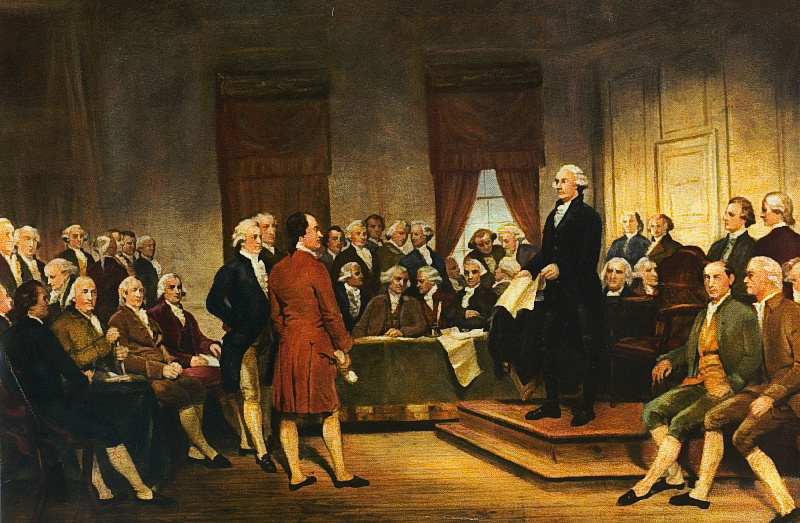The history book club I belong is going to discuss the founding documents of the United States rather than a specific book this week. As a result I have been reading and thinking about those documents, and have come to a somewhat different view than I had earlier.
 |
| John Trumbull's painting, Declaration of Independence |
The Declaration of Independence was promulgated in 1776, after the Revolutionary War had been going on for a year and the Americans had had initial success. The Declaration states in its preamble that its purpose is to explain to mankind why independence has been declared. I perceive that the Declaration was phrased in such a way as to gain support for independence. not simply as a statement of fact. Thus states, in all of which slavery was legal, declared all men equal with a right to freedom. The Declaration provides a long list of grievances, and rather than blaming the Parliament as the Continental Congress did two years before, blames the king. The Declaration of Independence was first sent to the supporters of independence in the American states to be read aloud, and then more widely distributed in printed form. It soon reached England and mainland Europe, and eventually Latin America.
The Articles of Confederation and Perpetual Union are dated 1778. They cobble together a confederation of independent states for common defense, for the security of their liberties and for their common welfare, but leave almost all the functions of government in those states. Actions of the Confederation generally require the consent of nine states. Canada is invited to join the Confederation.
The Battle of Yorktown, concluded in 1781 led to treaty negotiations, and the Treaty of Paris was signed ending the war in 1783 (ratified by the Congress of the Confederation in 1784). The British had lost the war in large part because France, the Netherlands and Spain had joined the Americans against Britain. The Treaty of Paris assigned territory to the United States from Canada to Florida, and from the Atlantic to the Mississippi.
The fragility of the United States of America struck me. France, England and Spain -- the great powers of the time -- all were actively managing colonies in the Americas. The states individually and collectively had a small population, a small economy, and little industrial capacity. If they did not stick together, it seemed very likely that territory would be picked off by one or another of the European powers, or perhaps shared among them. Not only did the states have to maintain their union, but they needed a form of common government that could provide military protection for all, and raise income to support the military. I suspect that they only dimly appreciated the economic value that the large common market would provide.
The Northwest Ordinance of 1787 by the Congress of the Confederation established governance over a large area. In that area, conflicting claims by several states had been ceded to the Confederation. The Ordinance included a bill of rights and outlawed slavery in the territory. It established procedures for the transformation of the territory into states as immigration provided sufficient population, which served as precedents for the development of the western states. It remained in force after the Constitution was ratified and the Constitutional government was established.
 |
| Constitutional Convention by Junius Brutus Stearns |
Small states managed to negotiate a compromise in which each state would have two senators in the Senate (while the delegations in the House of Representatives would be proportionate to its population). The states with economies dependent on the institution of slavery successfully protected that institution in the creation of the Constitution, and in fact gained representation in the House of Representatives including 3/5th of their slaves.
The Bill of Rights, the first ten amendments to the Constitution, was added as a result of concerns raised in the ratification of the Constitution. Twelve amendments were adopted by Congress in 1789, and the ten forming the Bill of Rights were ratified in 1791. They limit the power of the federal government over individuals and over states.
Here are a few useful websites for those interested in founding documents:
- The Federalist Papers
- The Founders' Constitution (An online version of a book with many documents)
- Constite (An online data base on constitutions of many countries)
No comments:
Post a Comment